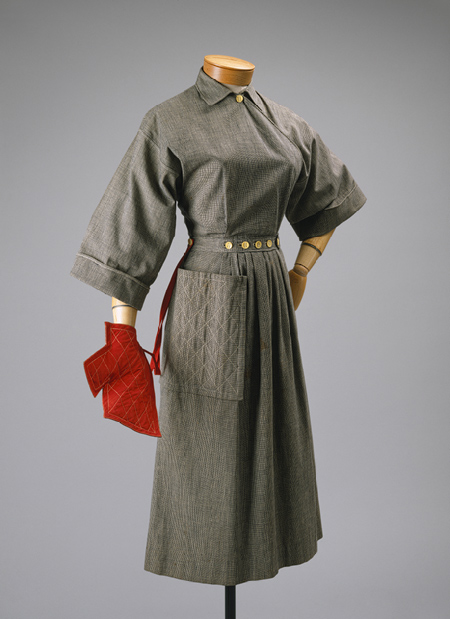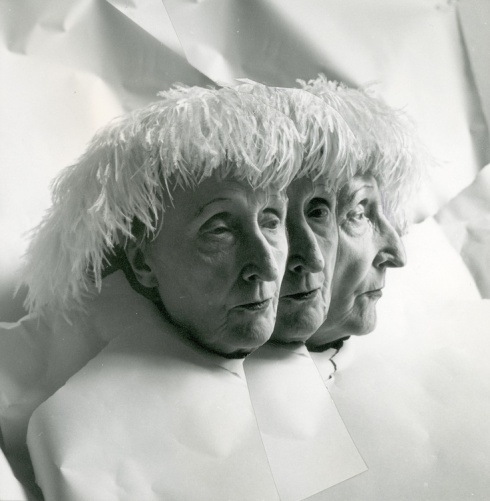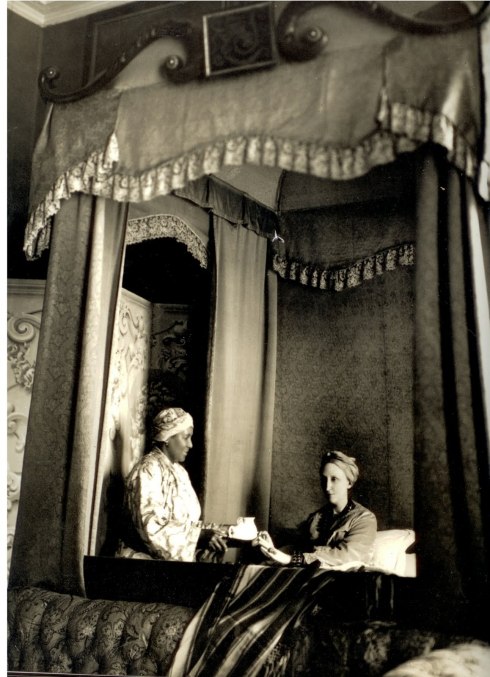![Claire McCardell]()
Claire McCardell
.
Claire McCardell was the founder of American ready-to-wear fashion, and in doing so defined what has become known as The American Look. She created casual but sophisticated clothes with a functional design, which reflected the lifestyles of American women. McCardell’s design philosophy was that clothes should be practical, comfortable, and feminine.
Claire addressed the subject of the great New York–Paris divide: “The basic difference,” she said, “is that we American women always look as if our feet were on the ground and European women mince.” She wasn’t speaking entirely metaphorically, either: She had popularized the ballet slipper as streetwear, when faced with leather shortages during the war; moreover, she built into her clothes “the McCardell slouch,” which she taught her models.
In 1955 Time Magazine published an article in which Claire McCardell’s designs were advertised “dresses that are as at home in the front seat of a station wagon as in the back seat of a Rolls, as comfortable in the vestibule of a motel as in the lobby of the Waldorf, as fitting for work in the office as for cocktails and dinner with the boss.”
“Claire started the feeling for Americana,” Vogue’s Babs Simpson told Time. “I’ve always designed things I needed myself. It just turns out that other people need them, too,” Claire quoted.
Her clothes were functional and simple with clean lines. They were considered subtly sexy with functional decorations. She utilized details from men’s work clothing, such as large pockets, denim fabric, blue-jean topstitching, metal rivets and trouser pleats. The idea of separates, in coordinating colors and creating endless configurations was revolutionary, because of its practicality and economic.
Before Claire, noboddy dared to use jersey, rayon, calico, seersucker, gingham, and cotton voiles for evening wear. She loved easy and accessible fasteners in her clothing, from zippers, to toggles, to rope. Her Madras cotton halter-style full-length hostess gowns were shown for evening.
.
Life magazine
Life publishes photographs (by Mark Shaw) of Claire’s designs made of fabrics created by major artists, including Pablo Picasso and Marc Chagall, in 1955.
![Claire McCardell top and slacks with Pablo Pacasso's print, in his studio, 1955]() Picasso-print ensemble
Picasso-print ensemble
![pablo picasso studio cannes 1955 mark shaw]() Picasso-print ensemble
Picasso-print ensemble
![Mark Shaw Marc Chagall in Studio, 1955 2]() Marc Chagall-print dress
Marc Chagall-print dress
![Claire McCardell dress with print designed by Marc Chagall, 1955]() Marc Chagall-print dress
Marc Chagall-print dress
![Fernand Leger-print dress]() Fernand Leger-print dress
Fernand Leger-print dress
![mark shaw joan miro and model in studio 1955]() Joan Miro-print dress
.
Joan Miro-print dress
.
Her design trademarks were double top-stitching, brass hardware replacing buttons with decorative hooks, spagetti ties, large patch pockets, and Empire waists. Claire also brought denim to the fashion forefront as a dress fabric, as well as mattress ticking, and wool fleece. Manmade fibers, too, were a source of innovation. She also loved leotards, hoods, pedal pushers, and dirndl skirts. Surprising color combinations were trademarks of Claire’s work.
The beauty of her clothes lay in the cut which then produced a clean, functional garment. Her clothes accentuated the female form without artificial understructures and padding. Rather than use shoulder pads, McCardell used the cut of the sleeve to enhance the shoulder. Relying on the bias cut, she created fitted bodices and swimsuits which flattered the wearer. Full circle skirts, neatly belted or sashed at the waist without crinolines underneath, a mandatory accessory for the New Look, created the illusion of the wasp waist. The clothes often had adjustable components, such as drawstring necklines and waists, to accommodate many different body types…
.
The American Look by Claire McCardell
![The American Look]()
![The American Look]()
![The American Look]()
![The American Look]()
![The American Look]()
![The American Look]()
Unfortunately, Claire’s life and work were cut short by a diagnosis of terminal colon cancer in 1957. Many believed that she was just then reaching the height of her career, and yet, despite the prognosis, the designer worked feverishly to complete her final collection. With the help of long-time friend and classmate at Parsons, Mildred Orrick, Claire completed her final collection from her hospital bed, getting up to alter the sketches when they were not to her liking. One of her brothers, Adrian, recalled how, “In spite of her impending death, anything coming out in her name she wanted to make sure was hers.” On the day of the show, Claire checked herself out of the hospital to personally introduce the collection. Many fashion followers realized this would be her final showing and crowded New York City’s Pierre Hotel for the show, giving her a standing ovation at the conclusion.
On March 22, 1958, at the age of 52, Claire McCardell passed away.
![Claire McCardell]()
“I’ve always designed things I needed myself. It just turns out that other people need them, too,”
.
McCardell’s innovations or “McCardellisms”
Claire contributed many “firsts” to the world of American fashion. Her revolutionary 1938 Monastic dress was certainly one such revolutionary innovation, as was her use of blue-jean stitching and trouser pleats and pockets in women’s clothing. Like the Monastic dress, the “popover” in 1942, a “wrap-around coverall in denim,” sold more than 75,000 copies in the first season alone and Claire included variations of the popover in every succeeding collection. She also modernized the dirndl skirt, a traditional German full skirt gathered at the waist, in 1938 and although it was not popular at first, variations of the dirndl skirt remain a popular clothing staple even today. She was also the first to incorporate the “riveted look” using “work-clothes grippers for fasteners and ornamentation. As one of the most innovative bathing-suits designers around, she introduced diaper and bloomer silhouette.s
Claire gave American women a look that set them apart from the traditional Parisian influences and helped make the everyday, such as homemaker chores, fashionable and stylish. At the same time, her designs encouraged American women to wear clothes that flattered their individual bodies and were comfortable, not restrictive ((Claire was the sworn enemy of shoulder pads), therefore ushering in a new approach to American fashion and women’s clothing.
She also started a craze for dance flats (especially Capezio) to be worn on the streets and even under evening dresses!
Sunglasses by Claire McCardell for Accessocraft
![Accessocraft]()
![Accessocraft]()
![Accessocraft]()
.
Exhibitions
Three Women – Madeleine Vionnet, Claire McCardell, Rei Kawakubo
![three_women_vionnet_mccardell_kawakubo_fit_1987_0]()
1987, exhibition in FIT-Fashion Institute of Technology-Museum: Curator: Richard Martin.
Due to this exhibition, the three designers work earned them a special award in 1987 from the Council of Fashion Designers of America
http://www.amazon.com/Three-Women-Madeleine-McCardell-Kawakubo/dp/B0044PP6O2
.
Claire McCardell: Redefining Modernism”
![redefining modernism]()
1998, exhibition opens at F.I.T. “In McCardell’s honest clothes,” publicist Eleanor Lambert writes, “you see the women of the Plains in a completely modern idiom.”
http://www.amazon.com/Claire-Mccardell-Kohle-Yohannan/dp/0810943751/ref=pd_bbs_sr_1/102-6081323-3268934?ie=UTF8&s=books&qid=1173982477&sr=8-
.
Book
What Shall I Wear? The What, Where, When and How Much of Fashion.
![what shal l wear]()
Book description:
The revolutionary fashion designer credited with originating “The American Look,” Claire McCardell designed for the emerging active lifestyle of women in the 1940s and ’50s. She was the originator of mix-and-match separates, open-backed sundresses, and feminine denim fashion; she started the trend for ballet flats as a wartime leather-rationing measure. Spaghetti straps, brass hooks and eyes as fasteners, rivets, menswear details and fabrics: they were all started by McCardell. Her Monastic and Pop-over dresses achieved cult status, and her fashions were taken up by working women, the suburban set, and high society alike.
First published in 1956, What Shall I Wear? is a distillation of McCardell’s democratic fashion philosophy and a chattily vivacious guide to looking effortlessly stylish. Mostly eschewing Paris, although she studied there and was influenced by Vionnet and Madame Gres, McCardell preferred an unadorned aesthetic; modern and minimalist, elegant and relaxed, even for evening, with wool jersey and tweed among her favorite fabrics.
What Shall I Wear? provides a glimpse into the sources of McCardell’s inspiration–travel, sports, the American leisure lifestyle, and her own closet–and how she transformed them into fashion, all the while approaching design from her chosen vantage point of usefulness. A retro treat for designers and everyone who loves fashion–vintage and contemporary–and teeming with charming illustrations and still-solid advice for finding your own best look, creatively shopping on a budget, and building a real wardrobe that is chic and individual, What Shall I Wear? is a tribute to the American spirit in fashion.
http://www.barnesandnoble.com/w/what-shall-i-wear-claire-mccardell/1118070664?ean=9781585679706
.
![photograph by Frances McLaughlin-Gill. Published in Vogue, November 15, 1944.]() .
.
Info: VoguePedia, http://msa.maryland.gov/megafile/msa/speccol/sc3500/sc3520/013500/013581/html/13581bio.html & The fashion encyclopedia
a lot of pictures found: http://www.metmuseum.org
Filed under:
biography ![]()
![]()
 Deborah Turbeville selfportait, 1978
Deborah Turbeville selfportait, 1978





 Victoria Guinness, 1983
.
Victoria Guinness, 1983
.
 Portrait of Carmen Freidberg, Mexico, 1997
.
Portrait of Carmen Freidberg, Mexico, 1997
.
 Corenlia and Bianca Brandolini D’adda- vogue italia
.
Corenlia and Bianca Brandolini D’adda- vogue italia
.
 Chloe Sevigny
.
Chloe Sevigny
.































































































































![07penn-500_thumb[2]](http://agnautacouture.files.wordpress.com/2014/08/07penn-500_thumb2.jpg?w=490&h=726)










































































































































































































































































































































































